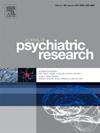Avoidant restrictive food intake disorder, traumatic events and PTSD in adolescents and adults admitted to residential treatment
IF 3.2
2区 医学
Q1 PSYCHIATRY
引用次数: 0
Abstract
Objective
Avoidant restrictive food intake disorder (ARFID) is a feeding and eating disorder linked to autism spectrum disorder (ASD) that has been associated with prior traumatic experiences, but its relationship to posttraumatic stress disorder (PTSD) has been relatively unexplored. Whether trauma and PTSD are more closely associated with specific clinical profiles of ARFID (fear of adverse consequences of eating, sensory sensitivity, and/or lack of interest in food/eating) is unclear.
Method
89 patients (25 adolescents, 64 adults) admitted to residential treatment (RT) with a DSM-5 diagnosis of ARFID completed initial assessments, including the PTSD Checklist for DSM-5. Trauma histories were identified via the Life Events Checklist for DSM-5 (adults), the Child Trauma Questionnaire (adolescents), and by detailed chart reviews.
Results
50 % of adults and 40 % of adolescents (47 % total) met criteria for PTSD, which was more prevalent in patients with sensory sensitivity (60 %) and pre-admission comorbid ASD (80 %). The most common types of traumatic experiences associated with PTSD were sexual assault, unwanted/uncomfortable sexual experiences, and physical assault. In most cases (61 %), traumas reportedly occurred before or at the same time as the eating disturbances, which began on average at 12.4 years of age. Patients with PTSD also had significantly more prior suicide attempts.
Discussion
Traumatic experiences and resultant PTSD were common in both adolescents and adults with ARFID, especially in those with sensory sensitivity and comorbid ASD. These findings need to be confirmed in larger, more representative samples. Development of treatment approaches that integrate trauma-focused treatments are indicated.
青少年和成人住院治疗中的回避性限制性食物摄入障碍、创伤性事件和创伤后应激障碍
目的:回避性限制性食物摄入障碍(ARFID)是一种与自闭症谱系障碍(ASD)相关的进食障碍,与先前的创伤经历有关,但其与创伤后应激障碍(PTSD)的关系尚未被探索。创伤和创伤后应激障碍是否与ARFID的特定临床特征(对饮食不良后果的恐惧、感觉敏感和/或对食物/饮食缺乏兴趣)更密切相关尚不清楚。方法89例(25名青少年,64名成人)接受住院治疗(RT)并被诊断为ARFID的患者完成了初步评估,包括DSM-5中的PTSD检查表。创伤史通过DSM-5生活事件检查表(成人)、儿童创伤问卷(青少年)和详细的图表回顾来确定。结果50%的成人和40%的青少年(47%)符合PTSD的标准,其中感觉敏感(60%)和入院前共病ASD(80%)患者更普遍。与创伤后应激障碍相关的最常见的创伤经历类型是性侵犯、不想要的/不舒服的性经历和身体攻击。据报道,在大多数病例中(61%),创伤发生在进食障碍之前或与进食障碍同时发生,平均开始于12.4岁。创伤后应激障碍患者之前也有明显更多的自杀企图。创伤经历和由此产生的创伤后应激障碍在ARFID的青少年和成人中都很常见,特别是在那些感觉敏感和共病ASD的患者中。这些发现需要在更大、更有代表性的样本中得到证实。指出了综合创伤治疗的治疗方法的发展。
本文章由计算机程序翻译,如有差异,请以英文原文为准。
求助全文
约1分钟内获得全文
求助全文
来源期刊

Journal of psychiatric research
医学-精神病学
CiteScore
7.30
自引率
2.10%
发文量
622
审稿时长
130 days
期刊介绍:
Founded in 1961 to report on the latest work in psychiatry and cognate disciplines, the Journal of Psychiatric Research is dedicated to innovative and timely studies of four important areas of research:
(1) clinical studies of all disciplines relating to psychiatric illness, as well as normal human behaviour, including biochemical, physiological, genetic, environmental, social, psychological and epidemiological factors;
(2) basic studies pertaining to psychiatry in such fields as neuropsychopharmacology, neuroendocrinology, electrophysiology, genetics, experimental psychology and epidemiology;
(3) the growing application of clinical laboratory techniques in psychiatry, including imagery and spectroscopy of the brain, molecular biology and computer sciences;
 求助内容:
求助内容: 应助结果提醒方式:
应助结果提醒方式:


